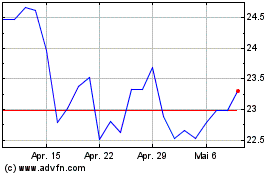Investors Still Wary About Gold Miners -- WSJ
25 September 2018 - 9:02AM
Dow Jones News
By Paul Garvey
This article is being republished as part of our daily
reproduction of WSJ.com articles that also appeared in the U.S.
print edition of The Wall Street Journal (September 25, 2018).
The mixed reaction to Monday's gold-mining megamerger
underscores the challenges facing the North American gold sector,
where shares have tumbled this year to discounts rarely seen
outside significant market downturns.
Investors heartily applauded Barrick Gold Corp.'s agreement to
buy Randgold Resources Ltd. for $6 billion in stock. Shares of
Barrick rose 6% and Randgold climbed 7%.
But other gold-mining companies rose only modestly, highlighting
the skepticism that Wall Street continues to hold for a sector hit
hard in recent years by a flat gold price and concerns that some
companies overextended themselves during the gold bull market that
ended earlier this decade. Shares of AngloGold Ashanti Ltd rose
1.4% and Newmont Mining Corp. was flat.
Shares of some of the biggest U.S.- and Canadian-listed
gold-mining companies are trading at an average of around 0.75
times their net asset value, 28% below where they were a year ago,
data from Macquarie tracking prices in the U.S. and Canada
show.
Price to asset value is a preferred measure for valuing mining
companies because it takes into account variables such as the
expected lifespan of mines and their output. The ratios are
subjective and vary from analyst to analyst based on their
assumptions.
A recent report by Bank of America showed that average
price-to-NAV ratios were touching levels seen only fleetingly in
2013, when gold prices plunged, in the 2008 crisis, and around 2000
and 2001, when gold hit a low of $256 a troy ounce, compared with
$1,207 Monday. Scotiabank estimates North American miners are
trading at about half of the historical global average.
Bullion has fallen 12% since its 52-week high in January, but it
isn't just gold prices that are weighing on the sector. North
American mining companies' weak valuations reflect a continuing
hangover from years of disastrous acquisitions and overleveraged
balance sheets, as well as more recent blunders involving new
mining projects.
Among the gold-mining companies with the weakest valuations,
Centerra Gold Inc. is trading at roughly 0.5 times its NAV,
according to the Macquarie data, after its shares fell 21% this
year. Detour Gold Corp.'s price-to-NAV is at about 0.6, the data
show, with the stock down 28% this year.
Barrick Gold and Randgold Resources have been hit as well. While
executives at the two companies have focused on keeping costs in
line and reining in debt, both are trading at steep discounts to
asset value following steady declines in their shares. Barrick's
price-to-NAV has fallen to 0.8 times after its shares slumped 30%
since the start of 2018, while Randgold is trading at 0.6 times its
NAV after its stock tumbled about 35% this year.
Joe Foster, portfolio manager of the $666 million Van Eck
International Investors Gold Fund, said North American gold stocks
were still working to unwind reputational damage they inflicted on
themselves during the mergers-and-acquisitions and development
frenzy leading up to gold's peak at nearly $1,900 in 2011.
"All these companies during the boom years, they were building
projects that didn't generate good returns and blowing out their
balance sheets and taking on too much debt," said Mr. Foster. "The
companies were very poorly managed, and they really fell out of
favor."
While some North American gold-mining companies have since
improved their performance, by lowering operating costs, selling
marginal assets and strengthening their balance sheets, they are
unlikely to reclaim their traditional price premiums without some
help from a gold price that is currently "stuck in the mud,"
according to Mr. Foster.
He said Barrick, along with Newmont Mining, Agnico Eagle Mines
Ltd. and B2Gold Corp., had "cleaned up their balance sheets" and
are "building projects with good returns."
Part of the problem is that dividends tend to be almost an
"afterthought" among North America's gold stocks, according to
Shree Kargutkar, a portfolio manager at Sprott Asset
Management.
In contrast, the dividends that have become a regular feature of
the Australian gold companies show not only the health of their
mines but a determination by management to remain disciplined and
reward shareholders along the way.
Australia's gold miners have also been insulated from the full
impact of the falling gold price due to the simultaneous fall in
the nation's currency, which has protected them from much of the
tumult affecting overseas rivals. Australia is the world's
second-biggest gold producer after China, where few gold-mining
companies are publicly listed.
Producers from Australia are trading at more than one times
their NAV. Mr. Foster said North American gold companies had
historically traded at a premium to their Australian rivals.
"Those valuations have flipped, and we've never seen that
before," he said.
Write to Paul Garvey at paul.garvey@wsj.com
(END) Dow Jones Newswires
September 25, 2018 02:47 ET (06:47 GMT)
Copyright (c) 2018 Dow Jones & Company, Inc.
Barrick Gold (TSX:ABX)
Historical Stock Chart
Von Mär 2024 bis Apr 2024

Barrick Gold (TSX:ABX)
Historical Stock Chart
Von Apr 2023 bis Apr 2024
